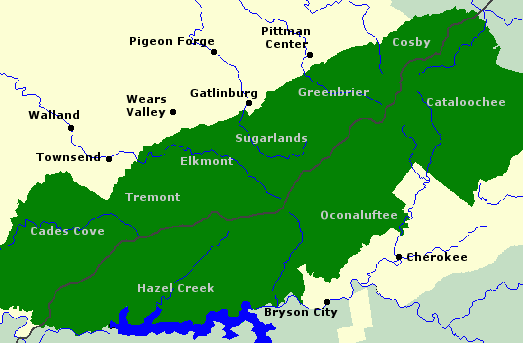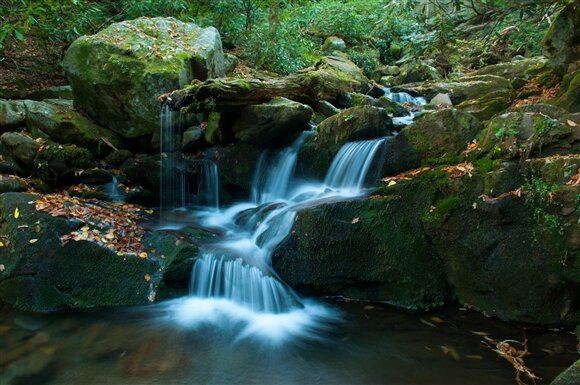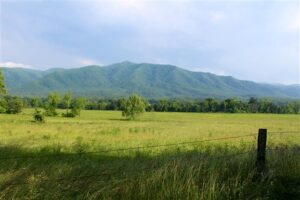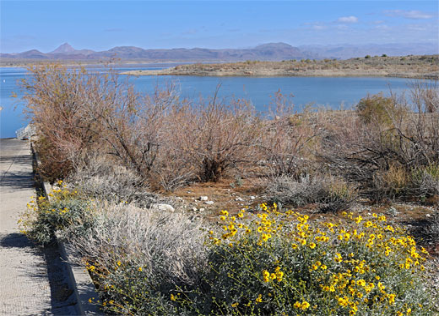Great Smoky Mountains National Park, nestled on the border between Tennessee and North Carolina, is renowned for its diverse range of ecosystems, breathtaking landscapes, and rich cultural history. As the most visited national park in the United States, it offers visitors an unparalleled experience of America’s natural beauty and heritage.

Natural Beauty
- Landscapes: This vast park is home to rolling mountains, dense forests, and a network of rivers and streams, creating a picturesque setting that changes with the seasons. The Smokies are part of the Appalachian Mountains and feature some of the highest peaks in eastern North America, including Clingmans Dome.
- Flora and Fauna: The park is recognized as an International Biosphere Reserve and a UNESCO World Heritage Site, boasting over 19,000 documented species. Its ancient mountains and diverse climates support a mix of deciduous and evergreen forests teeming with wildlife, from black bears to over 200 species of birds.

Camping and Accommodations
- Campsites: Visitors can choose from a variety of camping options, including front-country sites with amenities, backcountry sites for a more secluded experience, and group campgrounds. Advance reservations are highly recommended.
- Tips for Visitors: Booking early is essential, especially for peak seasons. Obtain necessary permits for backcountry camping, and familiarize yourself with park rules to ensure a safe and enjoyable visit.
Hiking and Trails
- Trail Highlights: The park features over 850 miles of trails, catering to all skill levels. Notable trails include the Appalachian Trail, which traverses the park, and the Alum Cave Trail to Mt. LeConte.
- What to Expect: Hikers can enjoy stunning views, historic structures, waterfalls, and diverse ecosystems. Always prepare for changing weather conditions and potential wildlife encounters.
Seasonal Attractions
- Best Times to Visit: Each season offers unique attractions, from wildflower blooms in spring, vibrant fall foliage, to serene snow-covered landscapes in winter.
- Special Events: The park organizes various events, including guided tours, educational programs, and the annual synchronous firefly viewing in early summer.

Protecting the Park Conservation efforts are vital for preserving the park’s natural and cultural resources. Visitors are encouraged to practice Leave No Trace principles to help maintain the park’s beauty for future generations.
Practical Information
- Getting There and Around: The park is accessible via several entrances, with the most popular being near Gatlinburg, TN, and Cherokee, NC. Exploring by car, bike, or foot offers different perspectives of the park’s landscapes.
- Amenities and Facilities: Visitor centers, restrooms, picnic areas, and other facilities are available to enhance your visit.
Visitor Tips and Recommendations
- Insider Tips: For a quieter experience, explore lesser-known areas of the park or visit during the off-peak seasons. Early mornings and weekdays are typically less crowded. Visitors Center
- Safety Reminders: Stay informed about trail conditions, prepare for the weather, and always maintain a safe distance from wildlife.
So What are you waiting for let get out and EXPLORE
Wildlife Photography: The park’s diverse ecosystems offer unique opportunities to capture stunning images of wildlife in their natural habitats, from black bears to elk and hundreds of bird species.
Historic Sites: The park is home to a rich tapestry of Appalachian culture, with numerous historic buildings, pioneer homesteads, and preserved settlements that offer a glimpse into the past.
Scenic Drives: Roads like the Newfound Gap Road and the Cades Cove Loop provide breathtaking views of the landscape from the comfort of your car, offering access to panoramic vistas, trailheads, and historic sites.
Waterfall Hikes: With numerous streams and rivers, the park boasts several beautiful waterfalls accessible through hiking trails, such as Abrams Falls and Laurel Falls, appealing to both casual visitors and avid hikers.
Picnicking: Many visitors enjoy picnicking in the numerous designated areas throughout the park, which offer beautiful settings for a leisurely meal amidst nature.
Biking: Cades Cove Loop Road is popular among cyclists for its relatively flat terrain and the opportunity to observe wildlife and historic buildings at a leisurely pace.
Fishing: The park’s streams are a haven for trout fishing, offering both native brook trout and other species in pristine mountain waters.
Autumn Leaf Peeping: The park is a prime destination for viewing fall foliage, with the diverse tree species providing a spectacular display of colors from late September through early November.
Cultural Events and Workshops: Seasonal events, including traditional music performances, cultural demonstrations, and educational programs, attract visitors interested in the Appalachian culture and natural history.
Stargazing: The park’s minimal light pollution makes it an excellent spot for stargazing, with several ranger-led night sky programs throughout the year.
Backcountry Exploration: For the more adventurous, the park offers extensive backcountry trails and campsites, providing a true wilderness experience.
Environmental Education: With its status as a UNESCO World Heritage Site and an International Biosphere Reserve, the park serves as a living classroom for environmental education and conservation practices.
These activities and attractions make Great Smoky Mountains National Park a versatile destination, catering to a wide range of interests from leisurely scenic drives and family picnics to adventurous backcountry excursions and in-depth cultural exploration.
I you would like to learn more about The Great Smoky Mountains please follow this link National Park Servies







